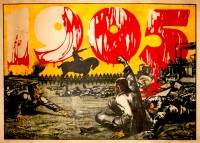Avilov, Mikhail Ivanovich
Born September 6, 1882, St. Petersburg, Russian Empire; died April 14, 1954, Leningrad, USSR
Mikhail Ivanovich Avilov was painter, graphic artist, illustrator and teacher in Imperial Russia and in the Soviet Union. Throughout his career the artist worked primarily in the battle genre and was a master of large-scale canvases dedicated to Russian military victories. Avilov was also engaged in book illustration and poster design from the 1930s to the 1950s. In 1903, he began his studies at the school of OPKh (Society for the Encouragement of the Arts) and Avilov also took private lessons from Lev Evgrafovich Dmitriev-Kavkazskii, a master engraver and etcher in St. Petersburg. From 1904 to 1913, he studied at the Higher Art School of Painting, Sculpture and Architecture in the Saint Petersburg Imperial Academy of Arts. Upon graduation, the artist completed the painting "Young Tsarevich and Boyars-Educators" (1913). That year, Avilov also created the canvas "Tsarevich Ivan Ivanovich on a walk”. The painting depicts the son of Ivan the Terrible with his bodyguards the oprichniki.
Avilov lived and worked in St. Petersburg and took part in exhibitions in the city. In 1916 he was awarded first prize by OPKh for his painting Oprichniki in Novogorod. During World War I, the artist served at the front and his battle sketches were published in Petrograd (St. Petersburg) magazines. After military demobilization, he resided in Irkutsk where he worked for the Department of Public Education. He taught in various schools in the city and was engaged in the design of squares and streets for civic holidays. After the Russian Revolution of 1917, Avilov worked as an illustrator for the State Publishing House. In 1923, he became a member of A.Kh.R.R. (Association of Artists of Revolutionary Russia). Avilov returned to Petrograd around 1921 to teach at OPKh. He also served on faculty at GSKhM (State Free Artistic Studios) / VHKUTEMAS (Russian State Art and Technical School), and from 1922 to 1930, he was on faculty at the Leningrad Art and Industrial College (formerly OPKh). Starting in 1947, Avilov taught at the Leningrad Institute of Painting, Sculpture and Architecture named after Illia Repin.
During the early Soviet-era, Avilov painted military-themed works such as: “Workers bring guns to Pugachev” and “Taras Bulba with sons” (both 1922); “Disarmament of the Kolchak army” and “Siberian partisans” (both 1926); “Breakthrough of the Polish front by the Budyonny Cavalry” (1927); and "Breakthrough of the Polish Front by the Army of the First Cavalry" (1928). The artist's historical paintings are notable for their multi-figure compositions and attention to details such as equipment, uniforms and weapons.
During the Second World War, the artist created the famous battle painting, "Duel of Peresvet with Chelubey at Kulikovo Field" (1943). Based on a 1914 work, the painting depicts a fight between a Russian named Alexander Peresvet and a Tatar named Chelibey. Avilov also designed posters during the war such as his 1941 title, Gubi gadov! (Cut the Bastards!) and 1942 titles Kavaleriiskaia ataka (Cavalry Attack) and Bili, b’em, i budem bit’ (We beat, We beat, and We will again beat!)
Mikhail Ivanovich Avilov was a member of the Union of Artists of the USSR and a member of the Academy of Arts of the USSR. He was bestowed the titles of Honored Artist of the RSFSR (1944) and People's Artist of the RSFSR (1953). In 1946, Avilov was awarded the Stalin Prize of the first degree.
Sources & Citations
Isakov, S.I. (1941). M.I. Avilov. Moskva: Iskusstvo. (p. 89 book on the career of the artist, list of works, cited)
Tramaviiskusstv.ru (bio)
arthive.com (birth and death dates, cited)
